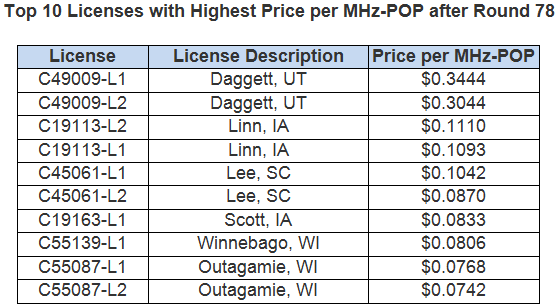
The U.S. Federal Communications Commission auctions wireless broadband spectrum to the highest bidders, and the agency’s latest spectrum auction continues to march toward a conclusion.
Auction 101 is the first of several auctions offering high-frequency “millimeter wave” spectrum that the Federal Communications Commission has committed to hold in 2018 and 2019. At the close of bidding in Round 78 Tuesday, total provisionally winning bids surpassed $689 million, although this total has not changed much over the past several days. While bidding has slowed recently, the FCC has said the auction will run through the end of the week, or as long as bidding continues, and then resume in the new year, if necessary.

The auction began on November 14 with forty qualified bidders. Three of the national wireless carriers are among the bidders, but none of the major cable providers are participating. The auction features 3,072 county-based licenses in two, 425-megahertz spectrum blocks in the 27.5-28.35 GHz (28 GHz) band. Much of the spectrum in this band was already licensed, and most of the license areas already had incumbents. In addition, the available spectrum only covered about 25 percent of the population, and did not include many major urban areas. These unique factors made it difficult to predict how the market would respond to the auction.
After more than a month of bidding, there are only 133 licenses with no provisionally winning bids. In Round 78, there were 21 bids totaling approximately $1.6 million. The total amount of provisionally winning bids through 78 rounds – just over $689 million – is near the middle of the range of $300 million to $1.3 billion, predicted by analysts at Morgan Stanley. The nationwide price per MHz-POP is $0.0111. At the December 12 open meeting of the Federal Communications Commission, Commissioner Carr said the auction’s performance was promising.
Bidding interest has been spread throughout the country where licenses were for sale. As the map below shows, there has not been any clear geographic trend in terms of where the highest value licenses are located.

At the end of Round 78, the licenses with the highest prices per MHz-POP were in Utah, Iowa, South Carolina, and Wisconsin.

The ten states with the highest provisionally winning bid totals were Wisconsin, Pennsylvania, Texas, Illinois, Iowa, Washington, North Carolina, Maine, California, and Oregon.

Shortly after Auction 101 concludes, the FCC will begin bidding in Auction 102 for 24 GHz spectrum. The auction will feature 2,909 Partial Economic Area (PEA) licenses in seven blocks. There will be two 100-megahertz blocks in the 24.25-24.45 GHz band and five 100-megahertz blocks in the 24.75-25.25 GHz band. The FCC will not release the identities of winning bidders in either Auction 101 or 102 until Auction 102 concludes next year. The FCC has said additional auctions will occur in the second half of 2019 for other millimeter wave bands.
The auctions are a significant component of the FCC’s Facilitate America’s Superiority in 5G Technology strategy, also known as the 5G FAST Plan, which is aimed at getting spectrum to market as quickly as possible. All told, the FCC has said it intends to release nearly 5 GHz of spectrum before then end of 2019.
[View source.]